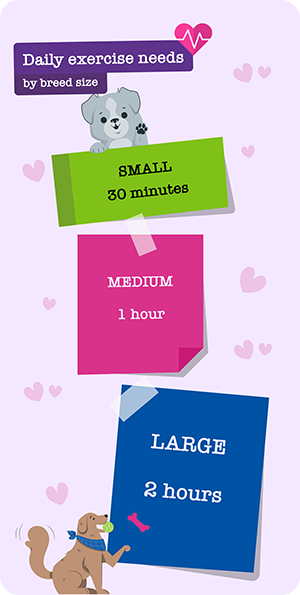Discover which dogs change the most in their first year, with all the information you need to know before choosing the right breed for you.
Getting a dog is a big decision, and there are plenty of things that are important to consider before you welcome a new canine friend into your home. Perhaps one of the biggest is how much your dog will grow. What might start out as the cutest little puppy can easily grow into something much bigger, and if you don’t have the physical space in your home and garden, you could soon find yourself with too much dog to handle.
So, to help you decide which breeds are the right fit for your lifestyle, we’ve analysed and sorted which pups grow the most in their first year. You'll also find expert advice on exercise needs, so you have everything you need before making your big decision.
The dogs who grow the most in height
While a little puppy might fit perfectly in your cosy home, as they start to grow they might start to find it a little claustrophobic. Big dogs need plenty of space to roam around in (both inside and out) so it’s worth keeping their growth in mind before you decide which one is right for you.
All dogs will grow taller as they get older, but these breeds might quickly turn out to be much more than you bargained for.
English Springer Spaniels are the dogs that grow most in their first year, increasing by 317% compared to their size as a puppy. They have long, smooth hair, and the bigger they get, the more of it you’ll need to groom! If you’re planning on adding a Weimaraner to your family, prepare to see it grow by 257% in the same period, while Dobermans and Boxers will also change a lot, growing 243% on average.
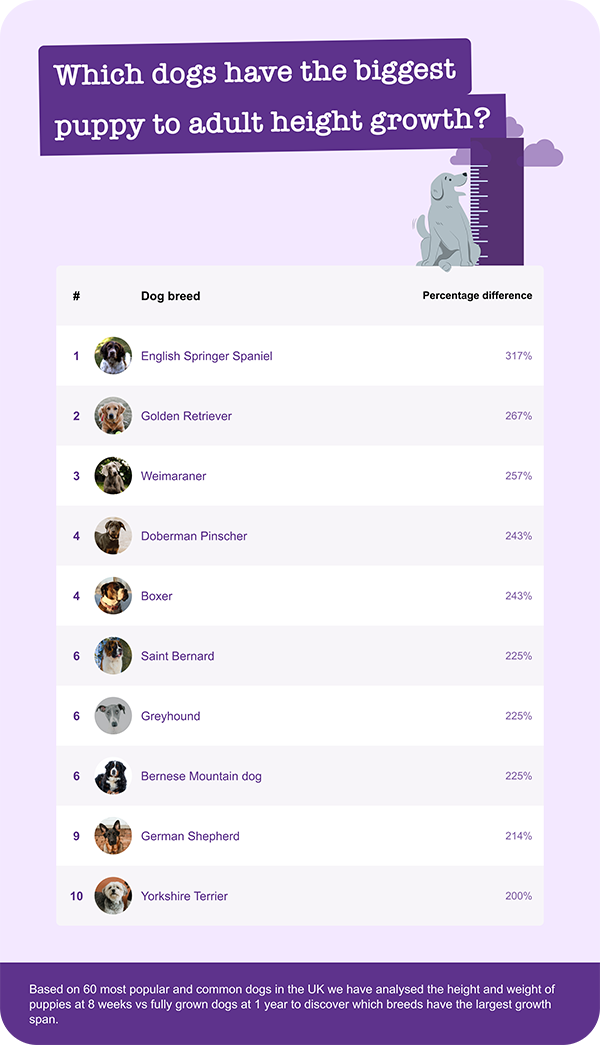
The dogs who pile on the pounds
A healthy dog will grow in weight as they get older. What you feed your dog, as well as how much food you give them, will contribute to growth, as will the addition of muscle mass through regular exercise. If you’re unsure about your dog’s needs it’s always worth asking your vet for advice. Labradoodles take the idea of growth to a whole new level. Their body weight increases by 900% by the time they reach a year, while Labrador Retrievers (700%), Rottweilers (692%) and Greyhounds (650%) aren’t far behind with their weight gain.
When it comes to caring for these dogs, you need to make sure they get exercised routinely or the extra pounds could soon become problematic. Be mindful about those puppy treats too, as it might seem easier to train them with an edible incentive, but those calories can add up and cause problems down the line.
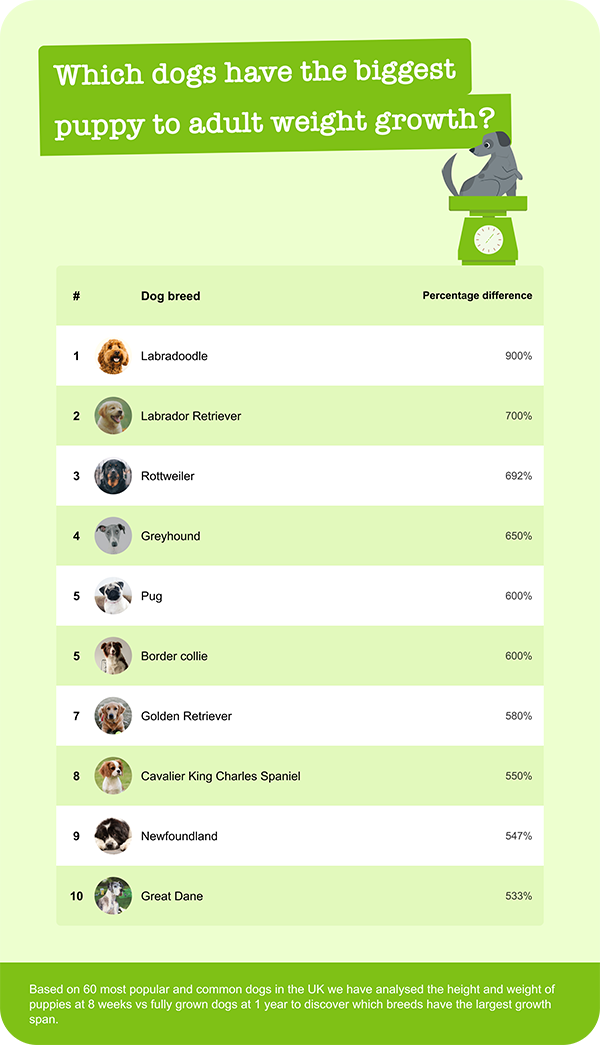
Some puppies stay pocket-sized
All dogs will experience some kind of growth spurt in their first year, and while many keep growing beyond their first birthday, some breeds grow slower than others in this period. Border Collies only increase their height by just 13% in that initial 12 months, turning a very cute puppy into an equally lovable (and super loyal) furry friend for life. Pugs (25%), perhaps unsurprisingly, are also low growers, as are Poodles (50%) and Chihuahuas (60%).
If you’re tempted by a shorter breed, there are a few things worth looking out for. Pedigree breeds like Cavalier King Charles Spaniels and Chihuahuas, and brachycephalic (flat-faced) breeds like Pugs and French Bulldogs, are often more prone to serious health concerns such as respiratory issues and heart conditions, and this is an important consideration that you’ll need to take as a potential owner. Plus, while you might want to carry these little pups everywhere, resist that temptation to ensure you’re giving them the exercise they need to avoid unhealthy weight gain.
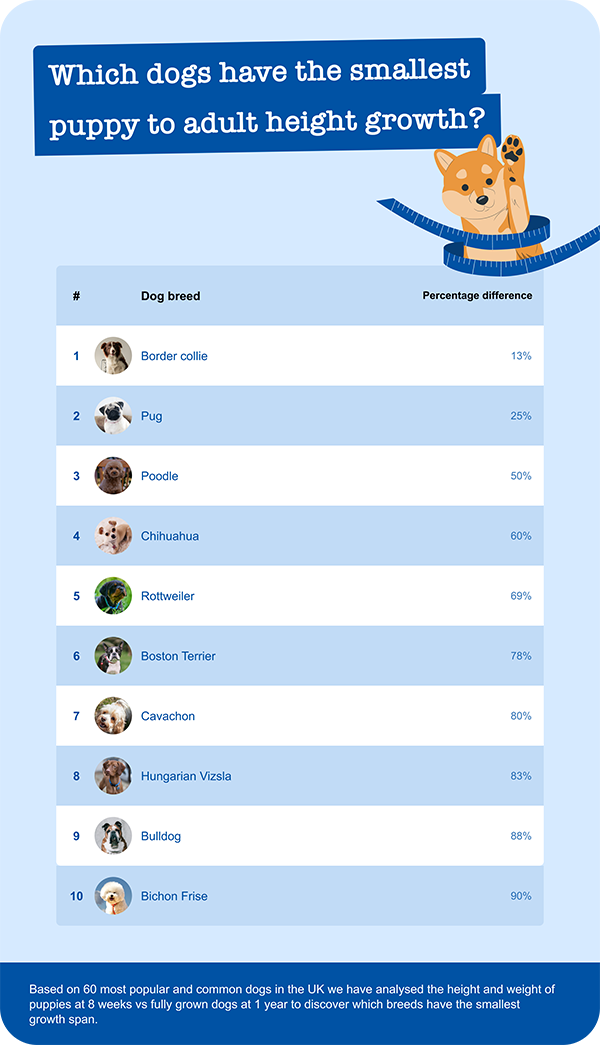
The dog breeds that don’t gain much weight
If your dog isn’t piling on the pounds, it might be due to a characteristic of their breed rather than their diet. Mini Cavapoos only add 50% to their body weight in their first year, staying, as the name suggests, mini. Chihuahuas are another famously small dog breed, who’ll increase their mass by 100%. Staffies grow by 118%, while both Yorkshire and Welsh Terriers are tied at 131%.
If your dog is a breed that naturally doesn’t weigh much, be careful not to overfeed them - their smaller frames can’t handle it! However, if you’re worried that your pup may be underweight or growing too slowly, it’s always worth a trip to the vet to rule out any underlying conditions.
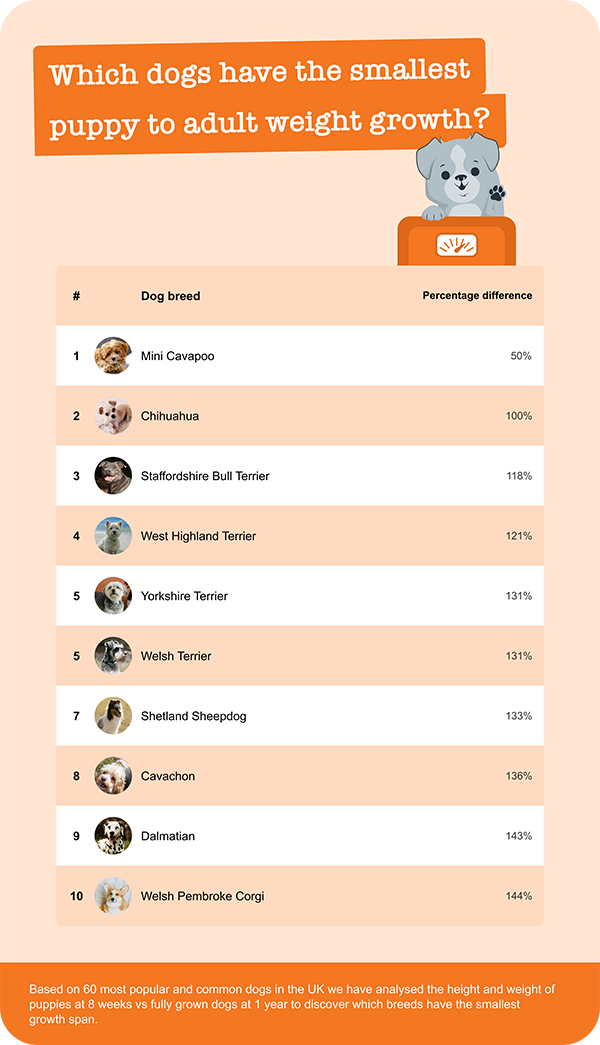
Which dogs need the most exercise?
All dogs need regular exercise to stay healthy and happy, but whether that means a quick stroll round the park or a long hike through the countryside is down to the breed you own. Generally, the bigger the dog, the more exercise it’ll need, while smaller dogs will enjoy shorter sessions.
Larger dogs like Boxers, Labradors and Great Danes all need at least two hours of exercise every day, which should include two long walks, runs or a few games of fetch. It’s crucial to make sure you can slot this kind of routine into your lifestyle if you’re thinking of getting a larger, more active breed.
Most smaller breeds, on the other hand, can get by with only 30 minutes of exercise a day, but there are some, like the active Jack Russell that will appreciate a longer walk. If you’re too busy or perhaps not that mobile yourself, dogs like Maltese Terriers, Pomeranians or Yorkshire Terriers might be better suited to you.
It’s always a good idea to mix your walking routes up. This keeps things interesting for both you and your dog, providing plenty of mental and physical stimulation.
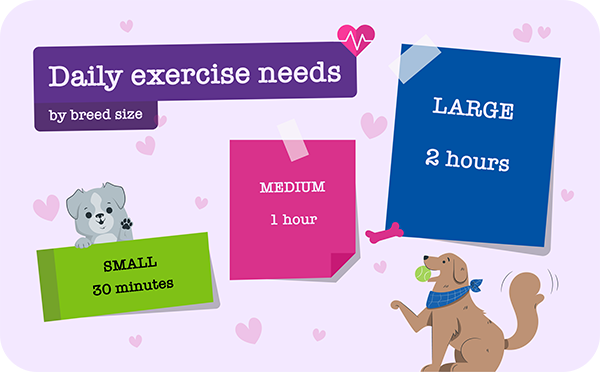
What our veterinary expert, Brian Faulkner, says
- What are some of the main things to consider when getting a dog, especially when it comes to the size of a breed? For instance, your living conditions, your lifestyle, your physical stamina, your finances?
Any dog, no matter the size, is for life, so making sure you’ve thought through every eventuality is important. On average dogs live for around 12 years, but some can live much longer. When considering a dog and choosing your breed, you should think about the following things:
- Do you have enough space inside and outside of your home to accommodate a dog? Larger breeds in particular will need lots of space inside simply to make life easier, whilst most dogs need a good amount of secure, outside space in which to stretch their legs.
- Do you have plenty of time to dedicate to a dog? Dogs are social creatures and love to be in the company of their families. You should make sure you have plenty of time to spend with your dog to prevent issues like separation anxiety, as well as time for training, exercise, play and general socialisation. Your dog should not be left on their own for more than 4 hours at a time.
- Are you able to walk or exercise your dog regularly? Different dog breeds require different amounts of exercise, ranging from around 30 minutes to 3 hours per day. Generally, larger breeds need more exercise to keep them fit and healthy as well as mentally stimulated, but some small breeds, such as active terriers, will also need a good length walk to keep them happy.
- Can you commit to the financial obligations that come with owning a dog? Just like any pet, dogs are a big responsibility, and there are costs associated with pet ownership. You will need to budget for food, vaccinations, neutering, parasite control, as well as vet care and pet insurance. Again, the breed of dog you choose will affect the exact amount you need to budget for – larger, more active breeds will eat more food, for example – but all dogs will need these basic care items.
- In what ways can it be harmful to your dog if they don’t have enough room or the right amount of exercise?
Obesity is the main physical health risk associated with a lack of exercise. Overweight dogs are more prone to certain medical conditions such as joint issues, heart problems and diabetes.
However, behavioural issues may also arise if your dog is bored or under-exercised. Behavioural issues are a common reason pet owners decide to rehome their pets, which is distressing for both your pet and the family, so it is important to make sure you and your home are well equipped for a pet before you commit. - Does a dog’s size have any financial implications, in terms of the purchase price as well as ongoing maintenance and care?
The purchase price of a puppy is determined by the supply and demand of a particular breed, rather than their size when fully grown; a Pomeranian puppy could be more expensive than a Labrador puppy, for example.
Ongoing maintenance and care costs will also vary depending on the breed of your dog. Flat-faced breeds, such as Pugs and French Bulldogs, tend to be more expensive to insure than other, larger breeds, due to their propensity for health conditions, such as respiratory issues and eye conditions.
However, size does matter in terms of ongoing costs when it comes to their food. Larger, more active breeds often need a higher calorie intake and therefore eat more food than smaller breeds. As a rough rule of thumb, a dog will eat five times its body weight in dry food per year. If your dog needs a tailored diet, for management of a medical condition such as kidney disease, or an allergy, this will cost more per kilogram of food.
Vaccinations, flea and worming treatments and neutering may also cost more for larger dogs, so this is worth bearing in mind. - Do you have any advice for people who find it challenging to take care of their growing dog?
The best thing to do is to make sure you do thorough research before you choose a dog, to make sure you will be able to accommodate your pet once they have reached their adult size. You could ask a local vet, your breeder or rehoming centre about the average size of the breed you’re interested in.
If you feel your dog is getting too large for your home, try to dedicate a particular space to them. Kit this out with their toys, food and water bowls and their own bed or crate in which they can feel comfortable. If your pet has their own space to settle in, they are less likely to feel confused and confined in a smaller home.
On top of this, make sure your dog is getting lots of exercise and mental stimulation, in accordance with their breed’s needs. If your dog is getting plenty of exercise elsewhere, they will be more likely to settle when they are at home.
If you’re worried about handling a larger dog, a qualified behaviourist or trainer can be helpful to build your confidence and tackle any unwanted behaviours such as jumping up or pulling on the lead, which can be more difficult to manage in larger breeds. - Should people choose a dog based on their size as a puppy – is this a good indicator of their adult size?
All dogs are small as puppies and their puppy size is not a reliable measure to use when considering which breed will suit your home and lifestyle. This is because different dog breeds have different growth rates and some pups could continue growing up until they are 2 years old. Again, proper research before you commit to a dog will help you understand what size your puppy might grow to and whether or not you’ll be able to accommodate them.
A dog’s adult size is a really important consideration to take into account when choosing a dog. As mentioned, there are a few important size-related implications you’ll need to consider, such as the cost of food and parasite control, and space in your home. However, it’s also important to remember that having a dog, of any size, is a big responsibility and the decision to welcome a pet into your home should be considered carefully.
Methodology
We have collated a seed list of the 60 most popular and common dog breeds in the UK, based on a range of data from The Kennel Club and HelloBark.
Gathering the data on each breed’s height and weight at 8 weeks (for a male puppy) and at 1 year (for a fully grown male), we have used this to rank which breeds have the biggest growth span from puppy to adult dog. We have also included each breed’s exercise needs.




